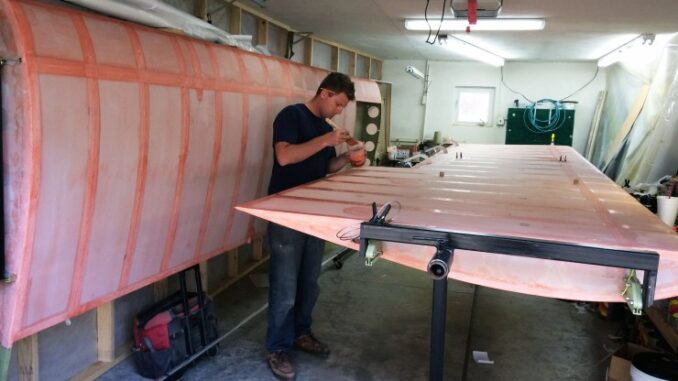
By Whitney Coyle, EAA 736036, New Smyrna Beach, Florida
Florida Breezy
My Breezy journey began back in 2008 with my first trip to AirVenture as a fresh A&P certificate at age 22. As soon as I saw the Breezys giving rides on the flightline I knew I had to experience the thrill. I waited in line each day as long as I could but was never able to get to the front. After returning from that trip I spent all my free time trying to find the bits and pieces I would need to build my own. A few years later, a friend called and mentioned he may have a partially completed fuselage he would be willing to trade for work on his Breezy in south Florida. I immediately took him up on the offer, but little did I know it would be a few more years before I could actually start building.
My mechanical experience began with parents who let me take everything apart and not necessarily put it back together, but my aviation mechanical knowledge is largely from the talented crew at American Aero Services and the constant guidance and patience from some of the most talented mechanics and restoration experts in the country.
When the opportunity arose to be a crew chief for the Collings Foundation bomber tour, I began my nearly three-year tour turning wrenches and flying some of the rarest aircraft in the world, and in the process met friends who would help define my aviation career. Mark Henley of the AeroShell T-6 team kindly let me fly his Breezy so I could decide if I had the guts to finish my own; after all, I’d heard that the width of a Breezy seat is inversely proportional to the altitude flown. Sure enough, it was one of the most exhilarating flights of my life.
After passing the torch for the duties of crew chief on to the next volunteer, I began the process of assessing the Breezy project and fitting the parts I had and determining what I would need. Since I had no drawings I went to Aircraft Spruce and called the number listed. Mrs. Unger picked up the phone, and when I asked to speak to Carl Unger, her only response was, “Is this about the Breezy drawings?” After a brief conversation and the check going in the mail, I was the proud owner of authentic Carl Unger drawings. The tubing in the fuselage needed some repairs and the front and rear seats needed to be fabricated, so work began with a rolling frame and purchase of a worn-out Continental O-200. After tearing down the engine and shipping the associated parts out for inspection and machining, I could concentrate on the big picture: I needed wings.
I began the long search for decent Piper-type wings on all the aviation classifieds and auction houses but quickly realized that the wings I could afford would need complete rework and covering. After calculating the cost, I decided I might as well build wings from scratch so I could trust what I would be flying under.

D&E Aircraft is right down the road, so I purchased a Super Cub-type wing kit with aluminum spars and ribs. The wings went together incredibly well, and about six months later I was ready to attempt my first Poly-Fiber covering. I now have incredible respect for the show-winning finishes that appear at Oshkosh every year. With seven coats of Aero-Thane, I hope I never have to do any repairs!

The first flight went well except for a weak radio, but the thrill came back immediately. Once the radio was figured out I could actually hear the tower asking where the rest of my airplane was. After the required 40 hours of flight testing, it was time to start giving rides as the Breezy was meant to. I had given 75 rides in the aircraft after flight testing when it was time to leave for Oshkosh. Everyone thought I was a bit crazy, but it would be my flight of passage. A Breezy is meant to give everyone the thrill of aviation and ignite the spark of homebuilding. The original designers intended it to be that way. Traveling 1,000 miles over three days to see 10,000 friends I’ve never met turned out to be the most memorable event of my life to date.
